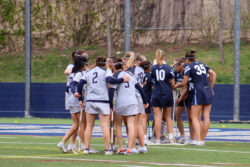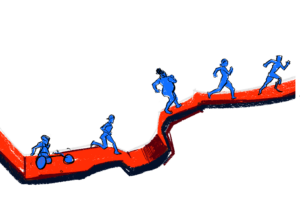If you’ve played soccer or flag football on Kehoe Field lately, you know about the landmines. You’ll be in the midst of a great run down the left wing, or backpedaling toward the end zone to break up a game-winning touchdown pass, when one of them sneaks out of nowhere, grabs your leg, and twists. You’ll writhe on the ground for a minute, stand up, and try to walk the injury off. No such luck. Whether it’s a sprained ankle, pulled hammy, or twisted knee, you’ve been bested again by one of those tricky Kehoe specials—the bumpy irregularities that litter Georgetown’s only recreation field for student use.
They haven’t always been there. Kehoe, originally constructed in 1942, was a natural grass field until 1979, when Yates Field House opened, bringing with it a brand new, all-weather Astro-turf playing pitch for intramural and club sports teams. The roof of Yates has been resurfaced, of course—most recently in 2004—but it has not been replaced. You can look far and wide on Georgetown’s campus for another place to play but to no avail: every other facility is either locked or varsity-only. Without any alternative, students continue filing up to Kehoe, accepting the limp that comes with the return trip.
Astroturf is supposed to be a low-maintenance, low-impact, and fast-playing alternative to grass. Unlike grass, though, Astroturf can warp and accrue ruts across its surface. The severe “turf-burns” it can inflict are nothing to scoff at either. This year, the Intramural Sports Department is allowing only one flag football game to be played at a time, evidently because there is only one section of the field deemed fit for play. The Georgetown women’s field hockey team, which played home games on Kehoe as recently as last year, has been barred from using the field for NCAA competition following an investigation last spring by the Department of Risk Management. Most of the club sports programs have eschewed playing there altogether, electing to practice in the dark or share space with other teams on Harbin Field, which uses a much softer, grassier variety of artificial turf.
According to Jim Gilroy, the Director of Yates Field House, plans are in the works to renovate Kehoe, but funding will be a big obstacle. Replacing the surface in 2004 cost seven million dollars, and Gilroy expects the pricetag this time around to be nearly double that. Yates’ management met with the University last week to discuss the issue, and another meeting is planned for November, but for now, Gilroy advises students to “be aware of the compressions [which are all marked with red and white X’s]” when setting up field space.
“Everyone understands that it needs to be replaced,” he said. “We’re pushing for it, trying to get it done, but finding the money is difficult.” Until then, keep your socks pulled up and watch out for those landmines—or better yet, why not just work on your jump shot?
Walker twisted his knee, help him up at wjl8@georgetown.edu.





